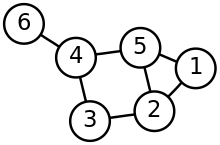Supplementary mathematics/Graph Theory
Graph theory or topology graph theory is a branch of mathematics and a field of discrete mathematics. Graph theory refers to networks of points that are connected and ordered and connected by lines. Graph applications in chemistry for formulation and form Classification of molecules and atoms, research and investigation in operations for tracking and clues in a research and computer science study have been used a lot to encode and determine the graph, and the graph has become a significant field in mathematics and discrete mathematics.

The history of graph theory goes back to 1735 in a special, principled and official way, which was discovered by a Swiss mathematician named Leonard Euler. It was a mathematical puzzle to find a path on each of the seven bridges that cross a forked river and pass by an island. Euler created an argument by drawing graph lines that there is no path at all. Proof This theorem was in the form of Fyric arrangement in bridges, but basically he proved the first theorem in graph theory.
The term graph means that the lines are connected to each other and have a graph scope, but it does not refer to data graphs such as linear, bar, circle. In general, graphs can be divided into two categories: graphs and Divided data. A graph refers to a set of vertices (points or nodes that are connected) and lines (lines that are connected).